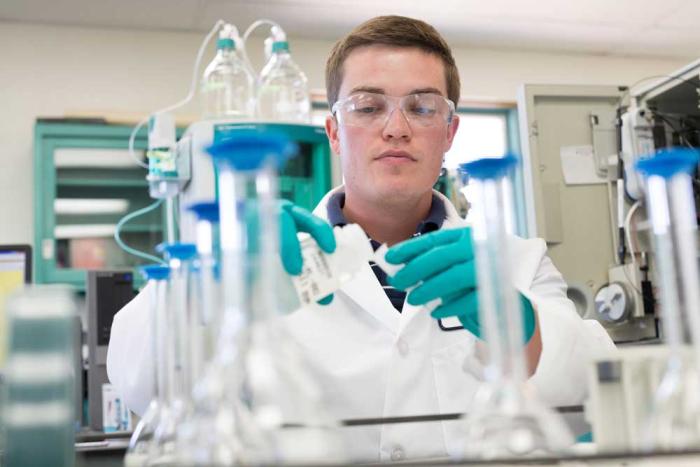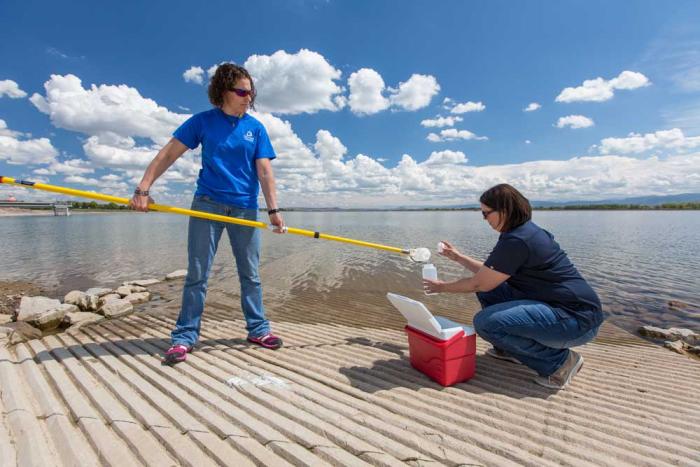Tackling PFAS in our society, environment
Editor’s note: On April 10, 2024, the Environmental Protection Agency finalized the first-ever national standard to limit PFAS in drinking water. This story has been updated, and more information about Denver Water and PFAS is available on this webpage.
Humankind revolves around innovation. New products and materials are always being developed to help us solve problems and make life more convenient.
But sometimes the new products also produce unintended negative consequences, which may not be discovered for decades — or even centuries. And often, the responsibility to fix these consequences is placed on water and wastewater utilities via the strict quality regulations they must follow.
Look at the lead pipe issue across our nation. At one time, using this cheap, pliable material made a lot of sense to ensure plumbers could easily and affordably connect a home’s plumbing to the public water system.
But we now know about the health impacts caused by this once innovative and sought-after product.
After years of adjusting its water chemistry to reduce the risk of lead getting into drinking water at homes with lead service lines, Denver Water in 2020 launched a proactive and industry-leading Lead Reduction Program to get at the heart of the issue — replacing tens of thousands of customer-owned lead service lines for its community.
“At the end of the day, our commitment is to ensure our customers have the cleanest, safest water possible,” said Nicole Poncelet-Johnson, director of water quality for Denver Water. “This becomes more and more challenging as new and innovative materials and products are developed that may have an impact on the water quality system down the line.”
The newest concern: PFAS, short for perfluoroalkyl and polyfluoroalkyl substances.
Used in fire-fighting foam, the chemicals extinguish fires quickly and keep them from reigniting. They are added to carpets, clothing, nonstick cookware, food packaging, plastic, coatings and much more. They repel water, grease and oil — preventing stains. PFAS are even found in some dental floss and high-end ski waxes designed to produce a faster, smoother glide down the mountain.
These are all products we value in our daily lives.
The chemicals also can get into the water cycle when firefighting foam seeps into groundwater supplies, or when PFAS-containing products breakdown and leach out of landfills, or when PFAS-containing products — such as cookware, cosmetics or water-resistant clothing — are washed with water, which picks up trace amounts of the chemicals and carries them down the drain and into the community’s wastewater system.
These chemicals are very strong and very difficult to break down, earning themselves the nickname the “forever chemicals.”
Denver Water’s new water quality laboratory will be on the CSU Spur campus at the National Western Center.
While human exposure to PFAS is far greater from using a range of everyday products, as noted above, a spotlight has been put on the water and wastewater industries to remove them from our environment, even the trace amounts that may appear in the water system.
In fact, in 2016, the Environmental Protection Agency issued a “health advisory” asking drinking water providers to test for two specific types of PFAS — called PFOA and PFOS — and look for anything over 70 parts per trillion for these two chemicals. And in June 2022, EPA issued a new, interim health advisory on those two kinds of PFAS in drinking water that included significantly lower limits (far lower than that 70 parts per trillion in the 2016 advisory).
While only a guideline, the June 2022 announcement triggered stories nationwide as the new trace amount testing limit is so low that even the best testing equipment isn’t able to measure with any confidence at that level — leading to some communities sending out public health advisories.
For perspective, the 2016 advisory’s 70 parts per trillion would be equivalent to 0.000001 of the 18,660 gallons one person typically uses inside the home over the course of an entire year. That includes all indoor uses, like laundry, flushing toilets, showers and washing dishes — not just drinking.
Editor’s note: On April 10, 2024, the Environmental Protection Agency issued the first-ever national standard to limit PFAS in drinking water. Learn more about the EPA's rules here.
Denver Water is committed to ensuring a clean, safe water supply for our customers that meets or goes beyond state and federal drinking water standards. Our experts are evaluating the Environmental Protection Agency’s first-ever regulation on PFAS in drinking water. Our initial review of the EPA’s proposed rule indicated the water Denver Water provides to customers tests well below the limits for the six PFAS compounds included in the agency’s rule. More information about Denver Water and PFAS is available on this webpage.
“It’s challenging to maintain public confidence when having to report on such a trace amount, especially when you consider studies have found higher levels of PFAS in the blood of people in the U.S.,” said Poncelet-Johnson.
She stressed that this isn’t to downplay the significance of PFAS exposure, as research has linked the chemicals to adverse human health impacts, including increased cholesterol levels, effects on the immune system, hormone system and infant birth weights.
“We need to evolve to a point where the policy is more focused on preventing contaminants from getting into the environment and water cycle, instead of needing to remove them after they’ve already been introduced,” she said.
Denver Water has always taken the risk of emerging contaminants seriously, testing above and beyond drinking water regulations.
Denver Water has been testing for PFAS-related compounds in source water and drinking water as the water comes into and goes out of the treatment plants since 2017.
The utility's experts are evaluating the Environmental Protection Agency’s first-ever regulation on PFAS in drinking water, issued on April 10, 2024. Their initial review of the EPA’s proposed rule indicated the water Denver Water provides to customers tests well below the limits for the six PFAS compounds included in the agency’s rule. More information on Denver Water and PFAS is available on this webpage.
Under the new EPA regulation, any utility that detects the targeted PFAS compounds above the regulated limits will be required to add new and costly treatment methods or find alternative sources of water — which isn’t always an available option in the water-starved West.
To stay ahead of the issue, a team of Denver Water’s water quality experts and scientists have been closely studying the evolving information about these chemicals and preparing for solutions in case future test results are above EPA-recommended levels.
Denver Water’s staff also has been involved in discussions with legislators, state and local regulators and its sister utilities on how to best find, control, remove and prevent PFAS contamination in water.
Following the 2022 legislative session, Colorado Gov. Jared Polis signed a new law (House Bill 1345) that will gradually restrict the sale of PFAS in consumer products, as well as fluids used in the extraction of oil and gas products, starting as early as 2024.
The law will prohibit the sale or distribution in Colorado of products that contain PFAS, such as cosmetics, carpets or rugs, fabric treatments, food packaging and juvenile products. Cookware that contains PFAS will have to carry a label.
“We take water quality seriously, and we know that tackling the PFAS issue is going to take all of us working together to protect our environment and find and use alternatives to these chemicals,” said Poncelet-Johnson.
“Progress begins with one and then many until we all are moving in the same direction.”





